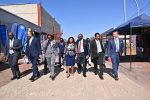Senior government officials and research leaders yesterday outlined a comprehensive national strategy positioning sustainable energy as the cornerstone of Namibia’s future economic growth, job creation, and climate resilience. Speaking at the Namibia Sustainable Energy Futures (NSEF) Dialogue, representatives from key ministries and the National Commission on Research, Science and Technology (NCRST) emphasized the critical link between human capital development, targeted innovation, and unlocking the nation’s vast renewable potential to drive prosperity.
Gerard Vries, Executive Director of the Ministry of Education, Innovation, Youth, Sport, Arts and Culture (MEIYSAC), framed energy not merely as a utility but as a fundamental national priority central to Vision 2030, the Harambee Prosperity Plan, National Development Program II, and international commitments like the Paris Agreement. He stressed that Namibia’s abundant solar, wind, and burgeoning green hydrogen resources offer unparalleled potential for regional leadership and global contribution to the energy transition. “Realizing this promise is crucial for reducing energy poverty, increasing economic growth, creating jobs, and enhancing resilience to climate change,” Vries declared.
Crucially, Vries positioned MEIYSAC at the heart of this economic transformation, arguing that sustainable energy fundamentally depends on a “knowledgeable, competent, innovative, and empowered” workforce. He detailed ongoing reforms across the education spectrum – from the Basic Education Act promoting equitable access to the Higher Education Act coordinating tertiary institutions – aimed at building the necessary skills base. Universities like the Namibia University of Science and Technology (NUST) and the University of Namibia (UNAM), alongside Vocational Training Centres (VTCs), are offering specialized programs such as Master’s degrees in Sustainable Energy Systems and Renewable Energy, and practical courses in solar PV maintenance. “These institutions are not merely places of learning; they are hubs for innovation, skill development, and workforce preparedness,” Vries stated, highlighting their role in feeding emerging industries like the green hydrogen value chain.
Vries outlined specific recommendations to bridge skills gaps, including strengthening industry-education cooperation for curriculum alignment and hands-on learning; investing in modular, lifelong learning programs for workforce upskilling in green technologies; encouraging STEM fields from an early age; addressing regional and gender inequities in training access; and establishing Regional Hubs and Centres of Excellence for sustainable mining and renewable energy research. He candidly addressed economic challenges, particularly the stark energy access divide where urban areas enjoy 77% access compared to only 38% in rural regions. Decentralized renewable solutions like solar home systems and mini-grids, coupled with financial incentives, are key strategies for ensuring an equitable transition that leaves no community behind economically.
Echoing the emphasis on research-driven economic strategy, Professor Anicia Peters, representing the NCRST, provided concrete details on translating potential into policy and action. She highlighted the pivotal role of Science, Technology, and Innovation (STI) in unlocking Namibia’s green hydrogen potential and establishing global leadership. “STI is pivotal… Through cutting-edge research and locally driven solutions, STI will transform ambition into action, powering sustainable growth for generations to come,” Peters asserted. She underscored the need for decisive investment in R&D infrastructure, skilled human capital, and strengthened innovation ecosystems.
Professor Peters spotlighted the critical, yet-to-be-published Namibia Energy Systems and Energy Transitioning Studies, conducted by NCRST in partnership with the Society for International Development (SID). This research, she revealed, provides a strategic blueprint, emphasizing the importance of a just transition. Significantly, the study explores leveraging Namibia’s recent oil and gas discoveries to strategically finance the renewable energy transition while adhering to climate commitments. It also tackles pressing economic hurdles like financing gaps, rural energy access, and stakeholder coordination. Peters urged dialogue participants to contribute insights to finalize the studies, which will form the basis for Cabinet-level policy briefs, academic papers, strategic action plans, and recommendations on skills accreditation.
Detailing NCRST’s proactive role, Peters outlined its responsibilities in Green Hydrogen (GH2) development: providing science-based policy advisory, integrating GH2 into national R&D agendas, and facilitating international capacity-building partnerships through MoUs. She announced the extension of the SID-NCRST partnership for another two years and previewed future programs including supporting industry-aligned curriculum development, establishing innovation ecosystems, collaborating with the Namibia Investment Promotion and Development Board (NIPDB) and universities on skills scaling, and developing strategic GH2 R&D programs under the National Programme on Research, Science, Technology, and Innovation (NPRSTI-II).
Peters also highlighted the Green Hydrogen Intern Programme, praising the contributions of Dr. Simeon Hamukoshi and interns Anna Amon and Ndapanda Musole, exemplifying the homegrown talent development essential for the sector. NCRST is actively engaged in national task teams on Green Hydrogen Education and Training, National Standards, and Critical Minerals governance, shaping the regulatory and skills frameworks vital for attracting investment and ensuring local economic benefit.
Both speakers united in a call for unprecedented collaboration. Vries envisioned the dialogue sparking “a movement towards more robust collaborations, significant investments in human resources,” aiming for “a sustainable Namibia where no one is left behind.” Peters urged “integrated efforts across public, private, academic, and international sectors” to ensure coordination and impact. “Only through collective action can we unlock Namibia’s full potential in renewable energy and build a sustainable, inclusive energy future,” she concluded, reaffirming NCRST’s commitment through NPRSTI-II funding, partnerships, and pilot projects.
The NSEF Dialogue has laid out a clear economic imperative: Namibia’s path to sustainable prosperity hinges on strategically harnessing its renewable energy wealth, underpinned by massive investment in education, skills, research, and innovation, ensuring the transition powers not just the grid, but the entire economy.










